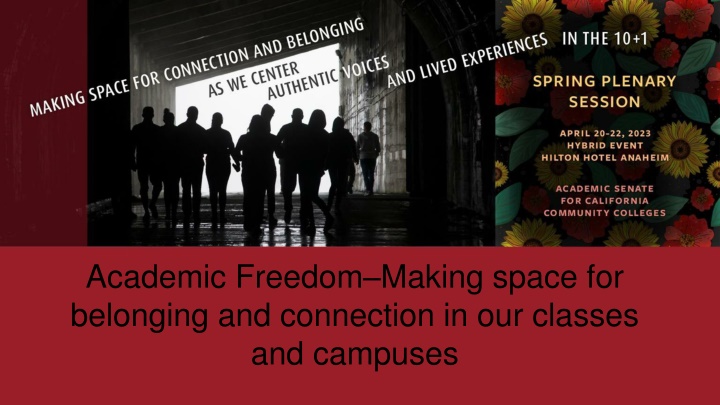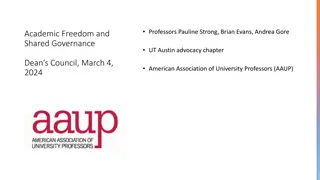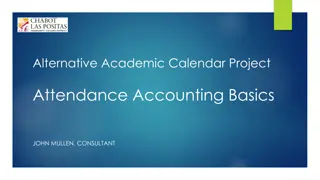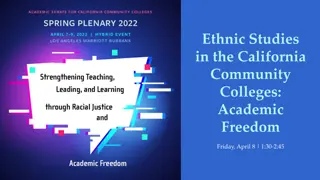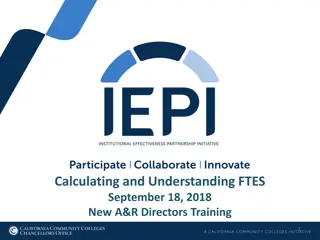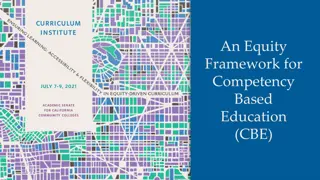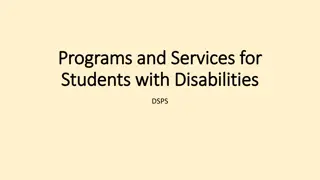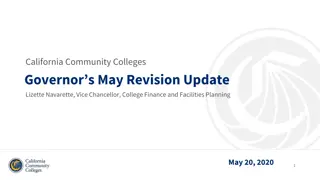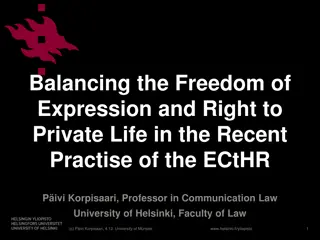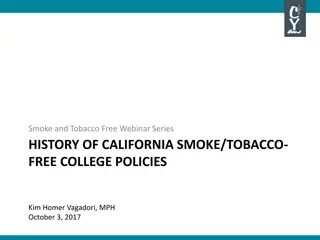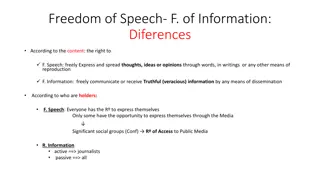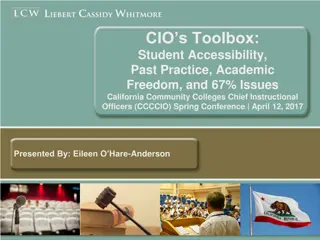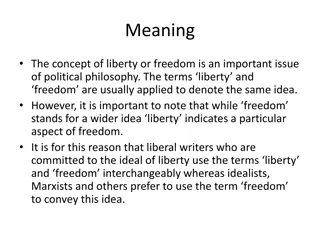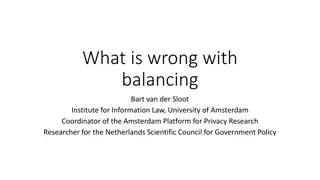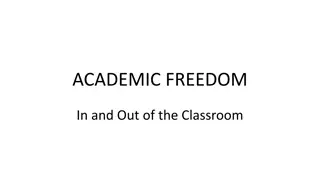Academic Freedom in California Community Colleges: Balancing Ideals in Education
Explore the intersection of academic freedom and inclusion efforts in California community colleges through legislative mandates, faculty responsibilities, and the role of academic senates. Discover the importance of maintaining intellectual integrity while creating spaces for belonging and connection in educational settings.
Download Presentation

Please find below an Image/Link to download the presentation.
The content on the website is provided AS IS for your information and personal use only. It may not be sold, licensed, or shared on other websites without obtaining consent from the author.If you encounter any issues during the download, it is possible that the publisher has removed the file from their server.
You are allowed to download the files provided on this website for personal or commercial use, subject to the condition that they are used lawfully. All files are the property of their respective owners.
The content on the website is provided AS IS for your information and personal use only. It may not be sold, licensed, or shared on other websites without obtaining consent from the author.
E N D
Presentation Transcript
Academic FreedomMaking space for belonging and connection in our classes and campuses
Session Description Heraclitus, the Greek philosopher said, Change is the only constant in life. For California community colleges, change has been the dominant element as witnessed by the plethora of legislative mandates and initiatives, issued in the last 8 to 10 years, seeking to bring about a more equitable educational experience for students. Many faculty have been working hard to incorporate inclusion, diversity, equity, Anti-racism, and accessibility (IDEAA) into their classes and colleges. Do these IDEAA efforts represent a challenge to academic and professional matters, in particular, academic freedom? What do these state mandates mean for the rights and responsibilities faculty have under academic freedom and the 10 + 1, in general, when creating educational spaces for students? Please join our breakout as we discuss how academic freedom is an important element to creating and making space for belonging and connection in our classes and colleges for all.
Session Outcomes Attendees will: 1. Gain an understanding of academic freedom by distinguishing between first amendment freedom of speech from academic freedom; 2. Recognize that academic freedom is not only necessary to the educator profession, but also for inclusion, diversity, equity, Anti-racism, and accessibility (IDEAA)-driven work; and 3. Identify the role that local academic senates and collective bargaining units play in establishing and protecting academic freedom in participatory governance spaces.
Academic Freedom Academic freedom establishes a faculty member s right to remain true to his or her pedagogical philosophy and intellectual commitments. It preserves the intellectual integrity of our educational system and thus serves the public good. Defining Academic Freedom ; Inside Higher Education, December 2020, https://www.insidehighered.com/views/2010/12/21/defining-academic-freedom.
Academic Freedom Defined ACADEMIC FREEDOM: Academic freedom is a fundamental concept that exists to ensure that institutions of higher education function for the public good and that colleges are constructed on the foundations of genuine trust. ACADEMIC FREEDOM Principles: Freedom in the classroom in discussing their subject Full freedom of research and in the publication of the results Freedom from institutional censorship or discipline in their extramural speech Title 5: Title 5 51023 requires governing boards of community college districts to adopt a policy statement on academic freedom, California Education Code does not include specific provisions protecting academic freedom, resulting in a wide variety of academic freedom policies across districts and colleges and a lack of the uniformity necessary to uphold and ensure the principles of academic freedom across all of California s community colleges (SR45, Min as of March 17, 2022)
Freedom of Speech 1stamendment right for faculty AND students Restricts the right of a public institution, including a public college or university, to regulate expression Instructors are not to required to provide class time for students to voice views that contradict the material being taught however, instructors are required to allow students to express opposing views and values to some extent where the instructor invites expression of students personal opinions and ideas In the classroom, speech must be germane to the discipline and advances an academic message (i.e., stick to your subject)
The Difference According to historian Joan Scott (2017), [there is a] difference between academic freedom a protection of faculty rights based on disciplinary competence and freedom of speech the right to express one s ideas, however true or false they may be. Free speech makes no distinction about quality; academic freedom does . Academic freedom protects teachers based on their expertise, inquiry, and critical thinking and acknowledges their authority in these areas based on education and experience. Academic freedom s purpose is to protect rights within the educational context of teaching, learning, and research.
The Value of Academic Freedom Our Nation is deeply committed to safeguarding academic freedom, which is of transcendent value to all of us, and not merely to the teachers concerned. That freedom is therefore a special concern of the First Amendment, which does not tolerate laws that cast a pall of orthodoxy over the classroom. -Justice William Brennan Jr. The classroom is peculiarly the 'marketplace of ideas.' The Nation's future depends upon leaders trained through wide exposure to that robust exchange of ideas which discovers truth 'out of a multitude of tongues, (rather) than through any kind of authoritative selection. -United States v Associated Press
Academic Freedom: Needed for IDEAA work ASCCC IDEAA Fall 2022 01.01 Resolution: Adopt the Academic Senate for California Community Colleges Mission, Vision, and Values Statements that Include Anti-Racism ASCCC Paper: Equity-Driven Systems: Student Equity and Achievement in the California Community Colleges ASCCC Paper: Anti-Racism Education in the California Community Colleges CCCCO DEIA Vision for Success Diversity, Equity and Inclusion Competencies and Criteria Recommendations
Academic Freedom: Needed for IDEAA Work Two Frameworks from the ASCCC to incorporate IDEA principles into curriculum: IDEAA Framework for Curriculum ASCCC Paper: Moving the Needle Equity, Cultural Responsiveness, and Anti-Racism in the Course Outline of Record ASCCC Presentation: The Course Outline of Record Through an Equity Lens ASCCC Presentation: Defining the Fourth Pillar Enhancing Teaching, Learning, and Equity ASCCC Presentation: Curriculum Design and Delivery through an Equity Lens OERI IDEA Framework for Instructional Materials Webinar: Inclusion, Diversity, Equity, and Anti-Racism (IDEA) A Process for Reviewing and Improving Courses and Course Resources Webinar: Open for Antiracism: Supporting Educators to Use Open Education for Antiracist Teaching 10
Academic Freedom and IDEAA The Connection between academic freedom and equity is fundamental. Without the rights of faculty to speak, research and pursue diverse ideas, equity is not possible. Academic Freedoms allow faculty to academically challenge racist ideologies and structures in the context of their expertise Academic Freedom allows students to be introduced to a diverse range of ideas that often contrast and compete with each other within an academic framework and invites them to participate in a rigorous analysis, the development of a independent critical judgement Allows faculty members the freedom to shape their courses in a way that allows for their subjects to be viewed, analyzed from different and specific lenses, particularly when the contrast with more traditional established theories.
Protecting Academic Freedom Locally and at the State Level
Protecting Academic Freedom Locally: Local Senates Adopted Positions of the ASCCC: Local senates should create a statement on academic freedom, in addition to local board policy, that delineates the specific issues and parameters of academic freedom for faculty. Local senates should provide consistent and ongoing professional development for full- and part-time faculty and senate leaders curriculum, program review, policy chairs, senators, etc. in the principles and tenets of academic freedom, including onboarding new faculty. Local senates should work to review, revise, and strengthen shared governance processes, policies, and procedures in relation to academic freedom so that shared governance protects dissenting opinions in the decision-making process. Protecting the Future of Academic Freedom During a Time of Significant Change
Protecting Academic Freedom Locally: Working with your Union Local academic senates should work with union colleagues to develop due process around violations or perceived violations that involve academic freedom issues, including a duly constituted appointed or elected faculty committee to review and recommend action. Local academic senates should collaborate with union colleagues on codifying the protection and parameters of academic freedom in contract in light of faculty evaluations, curriculum, online instruction, dual enrollment, open educational resources, guided pathways, and other relevant issues. Protecting the Future of Academic Freedom During a Time of Significant Change
More to do in collaboration with your Union Local academic senates should work with union colleagues to train faculty on engaging in faculty evaluations in light of academic freedom. Local academic senates should clearly delineate and provide justification for adjunct faculty participation in shared governance in order to support union efforts to negotiate appropriate compensation. Local academic senates and union colleagues should review AAUP resources and recommendations. Protecting the Future of Academic Freedom During a Time of Significant Change
Academic Freedom: Local Senates and Bargaining Units Advocates for Community College Faculty: Faculty Association of California Community Colleges (F.A.C.C.C.) Statewide Unions & Their Locals A.S.C.C.C. and its Legislative and Advocacy Committee Collective Bargaining Agreements Members of the California Legislature
Academic Freedom: Local Senates and Bargaining Units Why Now ? This Ask Costs Nothing Some states are Regressing on Academic Freedom Need to Assure Free Exchange of Ideas Let s Show Support for U.S. Faculty
Academic Freedom: Local Senates and Bargaining Units Steps You Can Take to Support Academic Freedom for CA Com Colleges: Pass The Resolution ! Put Academic Freedom in Your Collective Bargaining Agreemet Encourage State Legislators to Support Academic Freedom
Orange Coast College Academic Senates Resolution on Academic Freedom Resolved that the Academic Senate of __ requests the ASCCC and allied faculty advocates, to encourage members of the California State Legislature to introduce legislation in the current legislative session, affirming the right to Academic Freedom for faculty of California s community colleges.
Questions? Photo by Camylla Battani on Unsplash
References & Resources American Association of University Professors (AAUP) ASCCC Paper: Protecting the Future of Academic Freedom During a Time of Significant Change November 2020 ASCCC Rostrum (V lez & Curry): Academic Freedom and Equity ASCCC Paper: Developing Model Effective Senate-Union Relations ASCCC Paper: The Course Outline of Record A Curriculum Reference Guide Revisited
ASCCC Paper: Anti-Racism Education in the California Community Colleges ASCCC Paper: Equity-Driven Systems Student Equity and Achievement in the California Community Colleges ASCCC Paper: Going Beyond Development: Faculty Professional Learning An Academic Senate Obligation to Promote Equity-Minded Practices that Improve Instruction and Student Success ASCCC Paper: Moving the Needle Equity, Cultural Responsiveness, and Anti-Racism in the Course Outline of Record
ASCCC Presentation: The Course Outline of Record Through an Equity Lens ASCCC Presentation: Defining the Fourth Pillar Enhancing Teaching, Learning, and Equity ASCCC Presentation: Curriculum Design and Delivery through an Equity Lens Fall 2022 01.01 Resolution: Adopt the Academic Senate for California Community Colleges Mission, Vision, and Values Statements that Include Anti-Racism OERI IDEA Framework for Instructional Materials
